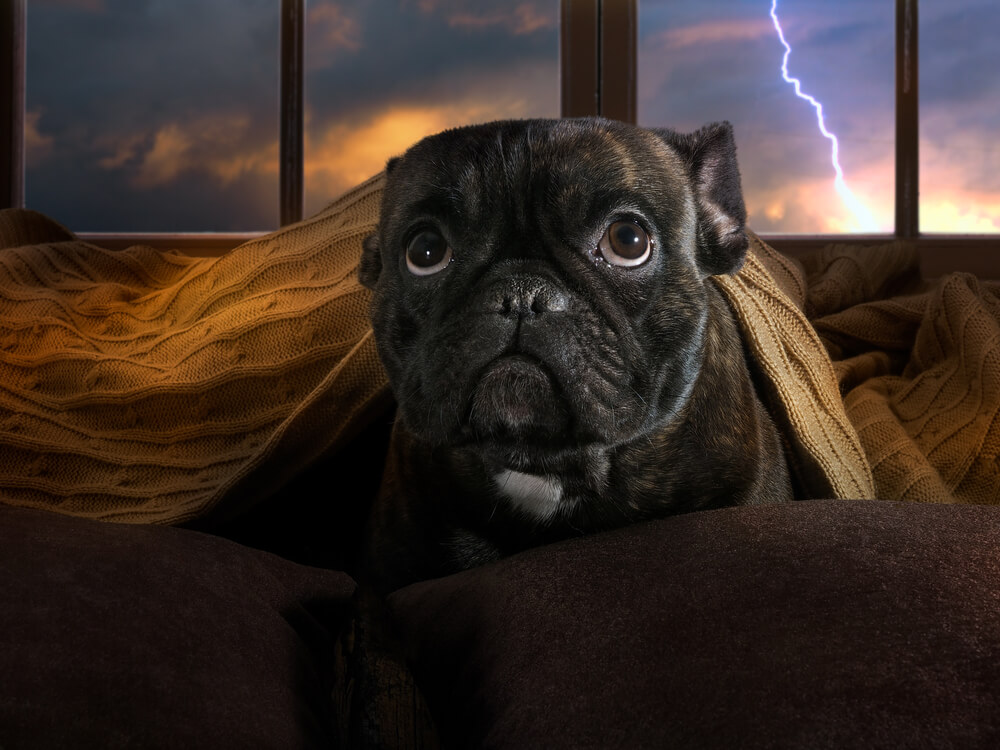Is your pooch afraid of thunderstorms and fireworks?
Management of Dogs with Noise Phobias
Does your dog start pacing and trembling when storm clouds start rolling in? Do they cower and hide when the kids down the street start to set off bottle rockets for the Fourth of July or New Years? A phobia is defined as a fear that’s more exaggerated than the proposed threat. We know that thunder and fireworks outdoors aren’t going to hurt your dog that spends most of their days stretched out on the couch in the creature comforts of air conditioning- but your dog doesn’t know that!
Remember that this is an emotional event for your pet, and not a bad behavior. Bad behavior, such as knocking the trash can over or barking at the UPS truck, can be modified. Emotions are not something we can train our pets to feel differently. Do not yell or punish your pet when they are fearful. This will only confuse them and exacerbate their fears.
Allow your dog to hide in safe places in the house. If your dog feels most comfortable in the closet, bathtub, or on a bookshelf after he removes all of the books (or is that just my dog?), allow them to stay where they feel comfortable. Do not force them out of their comfort zone. If this is a predictable place, make sure it’s safe for them (ie. taking shaving razors from bathtubs). You can make it more comfortable for them too! Put their favorite toy and old blankets in the area you know they like to hide. This gives them comfortable smells and objects to be around. Do not force them to confront their fear by leaving a comfortable area.
On the flip side, DO restrict access to doors that lead outside or gates that leave the yard if your pet is known for attempting escape when in fear. Make sure they are in a secure area. Holidays with fireworks are the most common times that people lose their pets!
Regardless if your pet tends to have a Houdini streak or not, be sure they are microchipped and wearing a collar with an identifying tag. Sometimes fear can cause pets to act out in ways they normally wouldn’t. A microchip will ensure that if your pet is found and taken to a shelter or veterinarian, they can be scanned and returned to you. This is a good reminder to make sure that your pet’s chip is associated with your correct phone number and address, in case those have changed since the chip was implanted.
To reduce your pet’s fear of what’s going on outdoors, whether that be fireworks or thunderstorms, you can make these simple modifications:
- Keep your windows closed
- “Black Out” Curtains: These can block all light (minimizes the flashing stimulus of fireworks or lightning) and their thick fabric can also help reduce sound
- White noise: Background noise in the house can help disguise what’s happening outdoors. You can use a white noise app on a phone, the TV (maybe not the movie Scarface though), or just play some music.
- Pheromone diffusers or collars: Feliway is a more well known feline pheromone that is used in vet hospitals to calm cats down. Sentry is a company that now produces similar products for dogs! These can come in the forms of plug-in diffusers or as collars
- Crate training: This ONLY works if your pet is already crate trained! Think of crates as your dog’s personal space. Dogs get their tendency to enjoy small and dark spaces from their wolf ancestors. Having a space that is never invaded by other pets or people is a refuge for many dogs. As any human introvert can tell you, having a regular space to retreat to where no one comes uninvited is a necessary part of managing anxiety. Dogs that are crate trained come to appreciate their “me space” and may choose to spend time in their crate during stressful events. This should be not only allowed, but encouraged.
And finally, about the “easy fix”- aka anxiolytic drugs.
Anxiolytic drugs are a wonderful tool to use in managing short term fearful situations in our pets. However, there is no such thing as a magic pill that will cure your dog’s fear altogether. Most drugs need to be given 1-2 hours prior to the fearful stimulus in addition to following the tips above.
You CANNOT toss a pill to your dog one hour after fireworks have started and expect to take them on a walk!
If you think your pet could benefit from drugs to reduce their anxiety during stressful events, we recommend giving them the drug on a day you can monitor them when nothing stressful is happening before using it on the big day. This ensures you can see how they will react to the medication without additional stimulus- it may be that your pet is more or less sensitive to the medication than other dogs and the dose may need to be adjusted. You can test your dog’s sensitivity to the medication by playing a youtube video of fireworks or a storm 1-2 hours after giving the medication and gauging their response. After about a minute, you’ll probably have a good idea of how your pet will react during an actual storm or fireworks. You can then stop playing the video and let them sleep off the rest of their medication and rest comfortably knowing that you and your pet are prepared to handle the real deal.
Do you have any questions? Have you tried doing all of these things and are still struggling with your pet being destructive when they’re afraid?
Please give us a call and schedule a consult with one of our veterinarians. We will be happy to guide you to the next step of behavioral modification and drug therapy.
Penelope Graben, DVM
Park Animal Hospital
Las Vegas, NV


